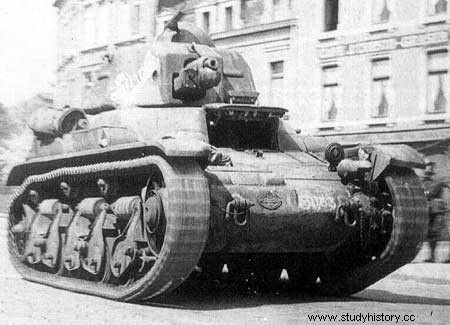
R-35 and German variants
Country France
Type: light tank.
Crew: 2 men.
Arming: a 37 mm cannon; a 7.5 mm coaxial. Shielding:maximum 45 mm.
Dimensions:
length: 4.2mm;
width: 1.85 mm;
height: 2.37mm.
Weight: 10 t.
Ground pressure: 0.67 kg/cm2.
Engine: Renault 4 cyl. gasoline, developing 82 hp at 2,200 rpm.
Performance:
road speed: 20 km/h;
autonomy. 140 km;
vertical obstacle: 0.5m;
clean break: 1.6 m (including grab bars);
slope: 60%.
Service time: introduced in 1936 in the French army, in fire until the armistice of 1940. Also used by Germany, Italy (which received tanks from Germany). Poland, Romania. Turkey and Yugoslavia.
In 1934, the French infantry launched a call for tenders for a new light tank to replace the very numerous Renault FT-17 two-seaters dating from the Great War and still in use (in fact this tank was to remain in service in the army French until 1940 and in the German army for a few more years).
The new machine was to weigh 8 t, have a two-man crew and a maximum road speed of 20 km/h, its armament to consist of two twin 7.5 mm machine guns or a single 37 mm cannon, and the shielding reach the maximum thickness of 40 mm.
Four companies submitted designs:Compagnie Générale de Construction de Locomotives, Delaunay-Belleville, FCM and Renault. The Renault model designated Renault ZM (or R-35) won the competition and the order for the first 300 units was placed in May.
The prototype was armed with twin 7.5 mm machine guns under the turret; the series models would deviate from it in many details. The running gear was derived from another Renault vehicle, the Automitrailleuse de Reconnaissance 1935 Type ZT, already declared fit for service.
R-35 production was between 1,600 and 1,900 units; at the declaration of war this tank was the most widespread of all French tanks and, moreover. often exported. In May 1940, the front line formations had 945 R-35/R-40 tanks, including 820 in the organic staffing of the armies and 135 others in the 4th DCR (Armored Reserve Division). As they were intended for infantry support, their lack of speed on the road only allowed them a very reduced strategic mobility.
The candidate submitted by FCM in response to the call for tenders of the 1930s was also adopted under the designation Char Léger Modèle 1936 FCM, but in 1940 production was limited to 100 units. enough to arm two battalions only. The FCM tank surpassed the 'R-35 in speed and especially in range. The diesel engine developed 90 hp and the suspension was similar to that used on the Char 81. The hull was of wrought steel. in this regard. the vehicle represented a certain progress. The weight in combat order was about 10.5 t. Some of these FCMs were converted into self-propelled guns after the German invasion.
As on most French tanks, the hull of the R35 was made of cast elements assembled by bolting. The driving position was at the front slightly offset to the left, with a hatch with two panels, one opening forward the other upwards, the operation of this last leaf being assisted by a hydraulic piston.
The APX turret, in the center of the hull, was identical to that of the Hotchkiss H-35 and H-39 tanks. The tank commander had his cupola but entered the turret through a rear hatch which. lowered, could also serve as a seat when the tank was not in action. The main armament consisted of a 37 mm SA 18 cannon, flanked by a 7.5 mm coaxial The ammunition load was 30 rounds of 37 mm and 2,400 rounds of 7.5 mm. ' /> The empty casings of the machine gun fell into a slide which evacuated them through the underbody. The latest production models mounted the 37 mm long-barreled SA 38 cannon. gas tank (of the self-sealing type) occupying the left part. A firewall separated the engine from the combat chamber.
The undercarriage bunched on each side. five rubberized wheels, the first independent, the others in two bogies themselves mounted on suspended angled oscillating arms. Sprocket at the front, tension wheel at the rear, three support rollers. Most machines of this type carried support bars that could be attached to the rear to increase the possibilities of the tank when crossing trenches.
In the early stages of its career, the vehicle lacked a radio but later production models did. This addition only added to the overwork of the captain who had to exercise command, of course, but also act as gunner and outfitter. Another development of the R-35 was the AMX 40 whose undercarriage featured twelve small road wheels. the sprocket at the front the tension wheel at the rear, the return of the caterpillar being ensured by four support rollers.
This suspension was significantly better than Renault's mechanism. Two battalions were equipped with AMX 40 (to which one also gave, sometimes, the designation of R-40) The R-35 also made use of tank with fascines. On this model, a frame ran from the front to the rear of the hull, over the turret, allowing the transport of a fascine which was thrown into the excavations to facilitate crossing.
Some tanks had a cast or wrought turret that had not yet been officially put into service. Other variants intended for experimentation include a mine detection tank and a guided tank.
The Germans assigned various missions to the R-35. The basic model did reconnaissance on the Eastern Front from 1941 under the designation of PzKpfw R-35 (4.7 cm). Many of these capture machines lost their turrets to become artillery Traktore or transporters
